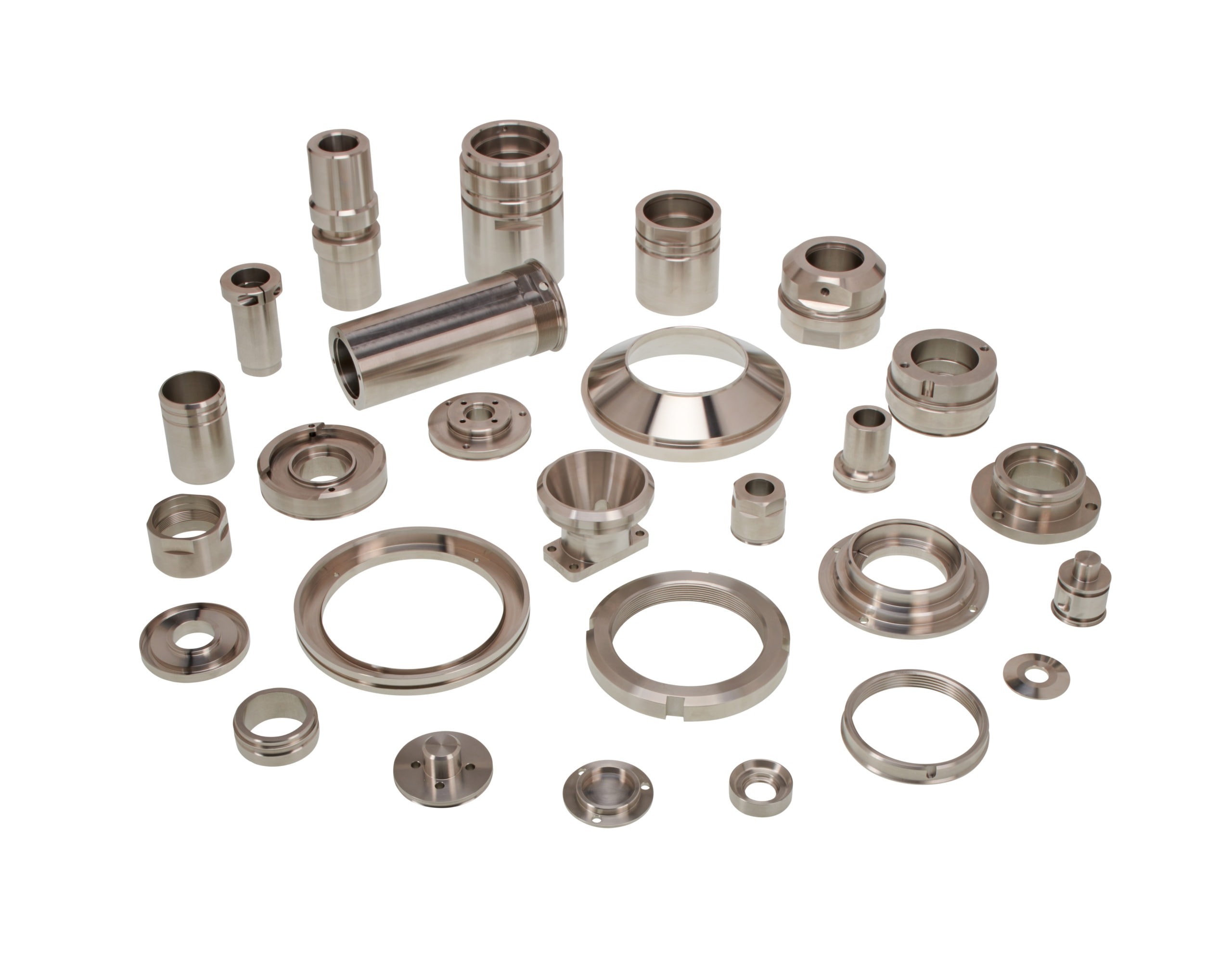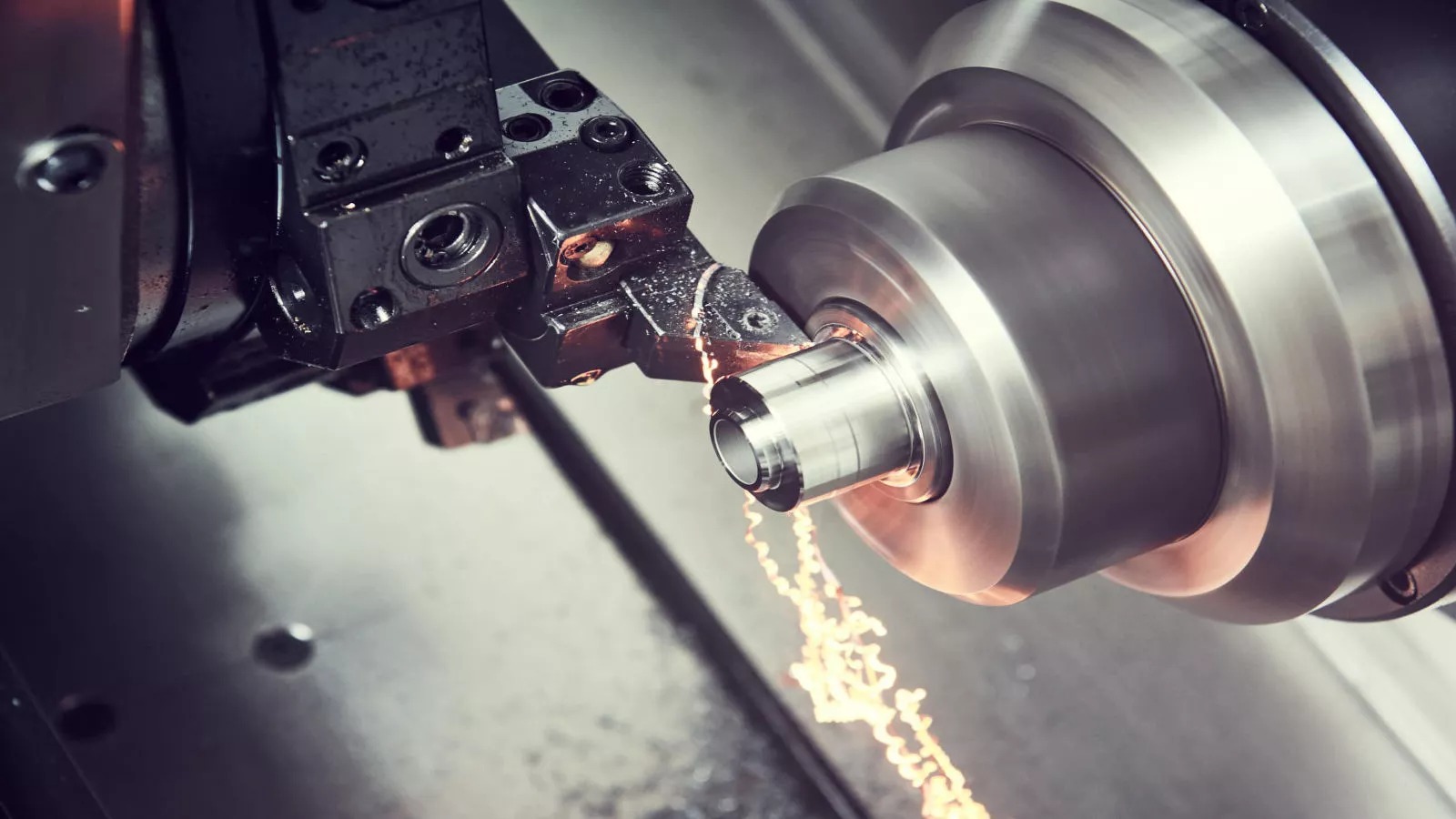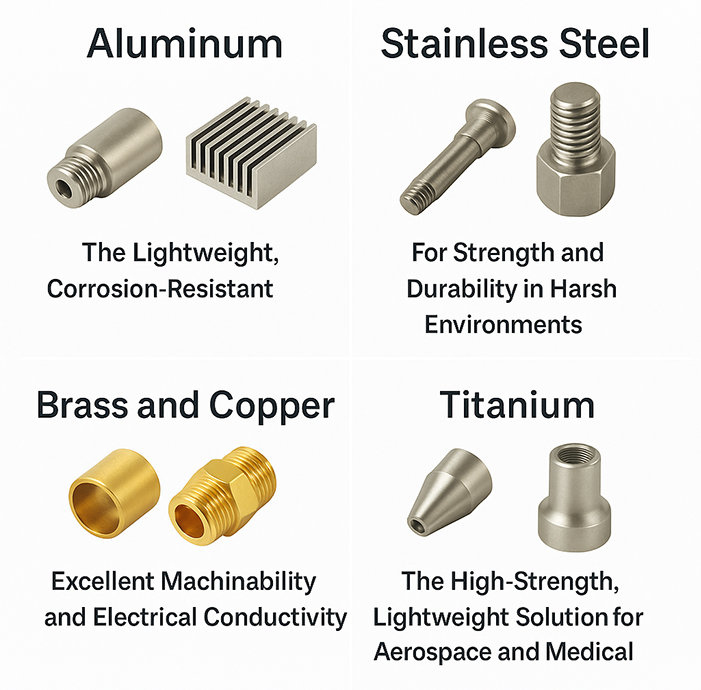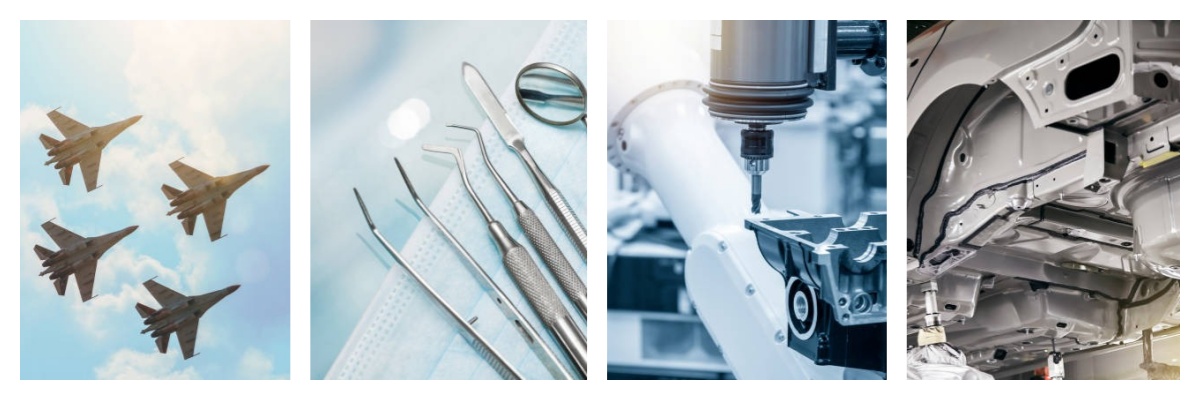Dale la vuelta al teléfono, mira debajo de un inyector de combustible y sujeta un taladro dental. Los dispositivos tienen pequeños ejes, pasadores y manguitos que encajan sin apenas grietas visibles. Estas secciones no se fabrican a granel ni a mano.
Se producen mediante tornos controlados por computadora, que hacen girar varillas de metal o plástico a muy altas velocidades con herramientas afiladas cortando capas finas hasta lograr la forma deseada.
Esto se conoce como torneado de precisión CNC, y sin él, todas las industrias de alta tecnología quedarían paralizadas. A continuación, se presenta una guía sobre cómo funciona el proceso y por qué, funcionalmente, es necesario buscarlo cuando se requieren piezas torneadas que, habitualmente, cumplen con una tolerancia estricta.
El torneado es un concepto simple. El material se retira sujetando una varilla redonda con una abrazadera y girándola alrededor del husillo, para luego mover una herramienta de corte de una sola punta en línea recta durante la rotación. El resultado es un cilindro, un cono o una ranura que se asemeja a la trayectoria de la herramienta.
CNC, la abreviatura de control numérico por computadora, se refiere a que cada movimiento es controlado por un programa en la memoria de la máquina. Tras la validación del código, el torno repite el ciclo sin intervención humana.
El fresado no es el caso, ya que la pieza permanece inalterada, pero la herramienta gira. El torneado deja la herramienta plana y la pieza en movimiento, por lo que es un método predilecto para ejes, roscas y la mayoría de los materiales redondos.

La precisión significa que el tamaño de la pieza se mantiene dentro de un rango que suele ser menor que el ancho de un cabello humano. Un objetivo común es de más o menos 0,0005 pulgadas.
La rugosidad superficial se mantiene a niveles de micropulgadas, y cada ranura, radio y rosca comienza en el mismo punto en la pieza uno y en la pieza diez mil. Los sistemas CNC alcanzan este nivel porque los servomotores mueven la herramienta sobre guías de husillo de bolas con retroalimentación de escalas de vidrio o codificadores rotatorios.
El trabajo comienza cuando un ingeniero abre el software CAD y dibuja la pieza en tres dimensiones. Cada agujero, rosca y chaflán queda completamente definido.
El modelo también contiene notas de tolerancia, símbolos de acabado superficial y referencias de materiales. Este archivo único se convierte en la referencia principal para cada paso siguiente.
Una máquina no puede arrancar usando el archivo CAD. El software CAM lee el modelo y requiere que el usuario seleccione las herramientas, velocidades y profundidades de corte. El software escribe el código G, que es una lista de texto con coordenadas y comandos. Una línea normal sería ajustar la torreta a X0.250 Z-0.500 con una velocidad de avance de 0.004 pulgadas por revolución.
Los postprocesadores modifican este código según el modelo específico de la máquina para que las velocidades del husillo, los comandos de refrigerante y las ubicaciones de cambio de herramienta estén en el formato del generador.
El técnico de montaje selecciona la máquina adecuada para el trabajo. Un torno de dos ejes maneja ejes simples. Un centro de torneado con herramientas motorizadas y movimiento en el eje Y añade planos y agujeros transversales con una sola sujeción.
Los tornos de tipo suizo sujetan piezas largas y delgadas con un casquillo guía, de modo que el material se mueve mientras el husillo permanece inmóvil. Una vez seleccionada la máquina, el operador carga la barra a través del orificio del husillo e instala las herramientas en la torreta. Cada herramienta se conecta a una referencia común para que la máquina sepa dónde se encuentra la punta en el espacio.
El programa CNC se inicia y el husillo acelera hasta las RPM programadas. La torreta indexa la primera herramienta, la mueve hacia la cara de la pieza y realiza un corte ligero para crear un arranque limpio.
A continuación, la herramienta se desplaza al diámetro exterior y retira material en pasadas que pueden tener solo 0,005 pulgadas de profundidad. Las herramientas de ranurado cortan ranuras para juntas tóricas, las herramientas de roscado forman roscas 4-40 UNF y las herramientas motorizadas perforan agujeros transversales sin mover la pieza a otra máquina.
El refrigerante inunda la zona de corte para disipar el calor y las virutas. El ciclo completo puede completarse en menos de un minuto para pernos simples o durar veinte minutos para implantes médicos complejos.
Al finalizar el ciclo, la pieza aún está caliente. El operador la retira, la deja enfriar a temperatura ambiente y luego verifica las dimensiones críticas.
Un micrómetro de 0 a 1 pulgada verifica el diámetro, una CMM traza el paso de la rosca y un comparador óptico proyecta el perfil en una pantalla para confirmar los radios. Si alguna lectura se desvía hacia el límite de tolerancia, el operador ajusta la compensación de la herramienta en el control y procesa la siguiente pieza. Este circuito cerrado mantiene el proceso estable durante toda la producción.

Un torno de dos ejes mueve la herramienta en X y Z. Refrenta, tornea y taladra a lo largo de la línea central. Estas máquinas son más económicas, se instalan rápidamente y producen miles de accesorios hidráulicos y ejes de motor a diario.
Las herramientas vivas se refieren al hecho de que la torreta tiene pequeños motores que hacen girar fresas, machos de roscar y taladros.
En lugar de transportar el componente a una fresadora, el torno da forma a una pieza plana, la fresa corta una chaveta o el macho de roscar corta un orificio transversal mientras el husillo permanece sujeto a la pieza. Una sola configuración ahorra tiempo y la precisión de la ubicación se mantiene dentro de los 0,0002 pulgadas.
A torno de 3 ejes Añade una corredera en el eje Y para que la herramienta pueda desplazarse descentrada. Una máquina de 4 ejes añade un segundo husillo o subhusillo para tomar la pieza del husillo principal y mecanizar la parte posterior.
Un sistema de 5 ejes inclina la herramienta o la pieza para cortar agujeros angulares o formas esculpidas. Estas opciones eliminan operaciones que antes requerían tres máquinas independientes.
Los tornos suizos introducen la barra a través de un casquillo guía ajustado, situado a solo unos milímetros de la zona de corte. El cabezal se desliza hacia adelante y hacia atrás, de modo que es el material el que se mueve en lugar de la herramienta.
Esta configuración evita que los tornillos largos y delgados se doblen y permite cortes pesados en diámetros de hasta 0,010 pulgadas. Los relojeros y proveedores de tornillos médicos confían en las máquinas suizas para producciones que alcanzan cantidades de seis cifras.
El aluminio 6061-T6 se desmenuza limpiamente y alcanza altas RPM, por lo que los tiempos de ciclo son cortos. Pesa un tercio del acero y se utiliza para fabricar disipadores de calor, piezas para drones y soportes para cámaras.
Los aceros inoxidables 303 y 316L resisten el agua salada y los ciclos de esterilización. Las herramientas quirúrgicas y los accesorios de grado alimenticio giran perfectamente gracias a sus insertos afilados de carburo y a su abundante refrigerante.
Mecanizado de latón 360 a alta velocidad, con un acabado brillante. El cobre 101 conduce tan bien la electricidad que las clavijas de los conectores se tornean a partir de varillas en lugar de estamparse.
El Ti-6Al-4V es ligero, pero soporta cargas elevadas. El problema reside en el calor, por lo que las máquinas funcionan a velocidades superficiales más bajas y con refrigerante a alta presión. Las articulaciones de cadera y los espaciadores de turbinas son piezas comunes.
El Inconel 718 mantiene su resistencia a 1200 °F, por lo que los motores a reacción lo utilizan para sellos y resaltes. Estas aleaciones se endurecen rápidamente, por lo que las herramientas requieren una geometría positiva y un acoplamiento constante.

Las máquinas Delrin se mecanizan como el latón blando y resisten el desgaste, por lo que los engranajes y los impulsores de las bombas giran a partir de varillas en tornos estándar.
El PEEK soporta vapor a 248 °C y ciclos de autoclave repetidos. Los instrumentos dentales y los implantes espinales suelen comenzar con una varilla de PEEK.
El PTFE se utiliza para fabricar asientos de válvulas y sellos que se asientan en las líneas de fluidos corrosivos. Es blando, por lo que las herramientas afiladas y los cortes ligeros evitan las marcas.
El nailon absorbe la humedad, por lo que las tolerancias deben permitir su crecimiento. ABS mecaniza de forma limpia y construye prototipos de carcasas que encajan a presión.
Una vez bloqueados el programa y las compensaciones, cada pieza sale de la máquina dentro del mismo rango estrecho. Esta repetibilidad permite que las líneas de montaje posteriores funcionen sin necesidad de ajustes manuales.
Los alimentadores de barras sostienen varillas de 3,6 metros y las introducen automáticamente en el husillo. Las máquinas funcionan durante toda la noche con un solo operario de servicio. Un centro de torneado puede terminar un conector de latón cada veinte segundos durante semanas.
Las geometrías de inserto modernas permiten acabados con una suavidad de hasta 8 micropulgadas Ra en acero. Las herramientas vivas cortan agujeros transversales y ranuras, por lo que la pieza no requiere una segunda fijación.
Desde plásticos blandos hasta superaleaciones de níquel, la misma máquina realiza el trabajo una vez que se eligen las velocidades, los avances y los recubrimientos de herramientas correctos.
El software CAM anida las piezas dentro de la longitud de la barra y minimiza los retales. Las virutas caen en las cintas transportadoras y regresan al reciclador, por lo que la pérdida de material se mantiene baja.
Los ejes de turbina, los pistones de actuador y los accesorios hidráulicos están fabricados con Inconel y Ti-6Al-4V. Cada pieza se entrega con certificados de materiales completos e informes de inspección que cumplen con la norma AS9100.
Los tornillos óseos, pilares dentales y conectores de catéteres requieren roscas medidas en diezmilésimas. Tornos suizos cortan estas formas a partir de varillas de acero inoxidable y PEEK de grado implante en salas blancas de clase 8.
Las boquillas de los inyectores de combustible, los pines del sensor ABS y los espaciadores del turbocompresor están fabricados con acero endurecido y aluminio. Los proveedores envían millones de unidades al año con valores de CpK superiores a 1,67.
Los rodillos transportadores, los carretes de válvulas neumáticas y las juntas robóticas se fabrican a partir de barras. El torneado de precisión mantiene los asientos de los rodamientos concéntricos para que los motores funcionen silenciosamente.

Pregunte si el taller cuenta con centros de torneado multieje con herramientas motorizadas y movimiento en el eje Y. Si sus piezas son largas y pequeñas, busque máquinas suizas. Un taller que invierte en nuevos accionamientos de husillo y cargadores de barras demuestra que está preparado para el volumen.
Busque como mínimo el registro ISO 9001:2015. El trabajo aeroespacial exige la aprobación de AS9100 y NADCAP. Solicite el programa de calibración de la CMM y los registros de capacitación del operador.
Un proveedor que ya mecaniza acero inoxidable 17-4 PH para instrumental quirúrgico conoce a los proveedores de herramientas y los trucos para el control de virutas. Esto acorta la curva de aprendizaje y reduce el riesgo.
Los buenos talleres revisan tu impresión y sugieren cambios de radio pequeños o tamaños de stock más ajustados para ahorrar dinero. Deberían cotizar prototipos en cuestión de días y compartir un video de la primera tirada para que puedas ver cómo vuelan los chips.
Los sensores monitorizan la carga del husillo, el desgaste de la herramienta y la temperatura. Los algoritmos aprenden los patrones y detienen el ciclo justo antes de que se rompa una herramienta. Los mismos datos optimizan los avances, por lo que los tiempos de ciclo se reducen unos segundos en cada pieza.
Los robots cargan las barras en bruto y descargan las piezas terminadas en contenedores. Los sistemas de visión detectan roscas faltantes y expulsan la chatarra automáticamente. Los talleres en regiones con salarios altos funcionan fines de semana enteros sin personal.
Un cabezal de revestimiento láser construye una brida sobre un eje, y luego el torno corta el diámetro exterior a la medida final. Una sola máquina realiza ambas tareas y ahorra semanas de tiempo de entrega.
Los colectores de niebla mantienen el aceite alejado del aire. Las centrífugas de virutas devuelven el refrigerante al cárter para su reutilización. Los variadores de frecuencia interrumpen la alimentación cuando disminuye la carga en vacío. Estas medidas reducen los costos y ayudan a cumplir con las nuevas normativas ambientales.
El torneado de precisión CNC transforma barras en bruto en componentes esenciales que pueden instalarse en teléfonos, motores a reacción e incluso equipos quirúrgicos. El control computarizado, las torretas multieje y el utillaje motorizado proporcionan tolerancias de diezmilésimas, y los alimentadores de barras garantizan el funcionamiento continuo de los husillos.
Los disipadores de calor de aluminio, los tornillos óseos de titanio y los espaciadores de turbina de Inconel también se moldean con la misma facilidad. Un modelo CAD claro es el primer paso hacia el éxito, seguido de un buen taller y, finalmente, datos de inspección que validan cada dimensión.
Con la integración de la IA, la robótica y los sistemas híbridos en el flujo de trabajo, la tecnología se volverá cada vez más ágil y ecológica. El torneado de precisión CNC representa la vía más corta entre la idea y el producto cuando se requieren piezas de precisión (redondas) que siempre deben ser correctas.